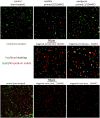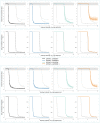Bacteria primed by antimicrobial peptides develop tolerance and persist
- PMID: 33788905
- PMCID: PMC8041211
- DOI: 10.1371/journal.ppat.1009443
Bacteria primed by antimicrobial peptides develop tolerance and persist
Abstract
Antimicrobial peptides (AMPs) are key components of innate immune defenses. Because of the antibiotic crisis, AMPs have also come into focus as new drugs. Here, we explore whether prior exposure to sub-lethal doses of AMPs increases bacterial survival and abets the evolution of resistance. We show that Escherichia coli primed by sub-lethal doses of AMPs develop tolerance and increase persistence by producing curli or colanic acid, responses linked to biofilm formation. We develop a population dynamic model that predicts that priming delays the clearance of infections and fuels the evolution of resistance. The effects we describe should apply to many AMPs and other drugs that target the cell surface. The optimal strategy to tackle tolerant or persistent cells requires high concentrations of AMPs and fast and long-lasting expression. Our findings also offer a new understanding of non-inherited drug resistance as an adaptive response and could lead to measures that slow the evolution of resistance.
Conflict of interest statement
The authors have declared that no competing interests exist.
Figures










Similar articles
-
Cationic antimicrobial peptides do not change recombination frequency in Escherichia coli.Biol Lett. 2018 Mar;14(3):20180006. doi: 10.1098/rsbl.2018.0006. Biol Lett. 2018. PMID: 29563281 Free PMC article.
-
Synergism between Host Defence Peptides and Antibiotics Against Bacterial Infections.Curr Top Med Chem. 2020;20(14):1238-1263. doi: 10.2174/1568026620666200303122626. Curr Top Med Chem. 2020. PMID: 32124698 Review.
-
Antimicrobial Peptides: the Achilles' Heel of Antibiotic Resistance?Probiotics Antimicrob Proteins. 2019 Jun;11(2):370-381. doi: 10.1007/s12602-018-9465-0. Probiotics Antimicrob Proteins. 2019. PMID: 30229514 Review.
-
Defensive remodeling: How bacterial surface properties and biofilm formation promote resistance to antimicrobial peptides.Biochim Biophys Acta. 2015 Nov;1848(11 Pt B):3089-100. doi: 10.1016/j.bbamem.2015.05.022. Epub 2015 Jun 4. Biochim Biophys Acta. 2015. PMID: 26051126 Review.
-
Investigating specific bacterial resistance to AMPs by using a magainin I-resistant Escherichia coli model.J Antibiot (Tokyo). 2014 Oct;67(10):681-7. doi: 10.1038/ja.2014.48. Epub 2014 May 7. J Antibiot (Tokyo). 2014. PMID: 24802209
Cited by
-
Antimicrobial peptides and the gut microbiome in inflammatory bowel disease.World J Gastroenterol. 2021 Nov 21;27(43):7402-7422. doi: 10.3748/wjg.v27.i43.7402. World J Gastroenterol. 2021. PMID: 34887639 Free PMC article.
-
Standardizing characterization of membrane active peptides with microfluidics.Biomicrofluidics. 2021 Jul 7;15(4):041301. doi: 10.1063/5.0048906. eCollection 2021 Jul. Biomicrofluidics. 2021. PMID: 34257793 Free PMC article.
-
The Effect of Antimicrobial Peptide (PA-13) on Escherichia coli Carrying Antibiotic-Resistant Genes Isolated from Boar Semen.Antibiotics (Basel). 2024 Jan 31;13(2):138. doi: 10.3390/antibiotics13020138. Antibiotics (Basel). 2024. PMID: 38391525 Free PMC article.
-
Polypharmacological Cell-Penetrating Peptides from Venomous Marine Animals Based on Immunomodulating, Antimicrobial, and Anticancer Properties.Mar Drugs. 2022 Dec 4;20(12):763. doi: 10.3390/md20120763. Mar Drugs. 2022. PMID: 36547910 Free PMC article.
-
Single-cell stochastic modelling of the action of antimicrobial peptides on bacteria.J R Soc Interface. 2021 Sep;18(182):20210392. doi: 10.1098/rsif.2021.0392. Epub 2021 Sep 15. J R Soc Interface. 2021. PMID: 34520689 Free PMC article.
References
-
- Koo HB, Seo J. Antimicrobial peptides under clinical investigation. Pept Sci. John Wiley and Sons Inc.; 2019;111. 10.1002/pep2.24122 - DOI
Publication types
MeSH terms
Substances
Associated data
LinkOut - more resources
Full Text Sources
Other Literature Sources
Medical

